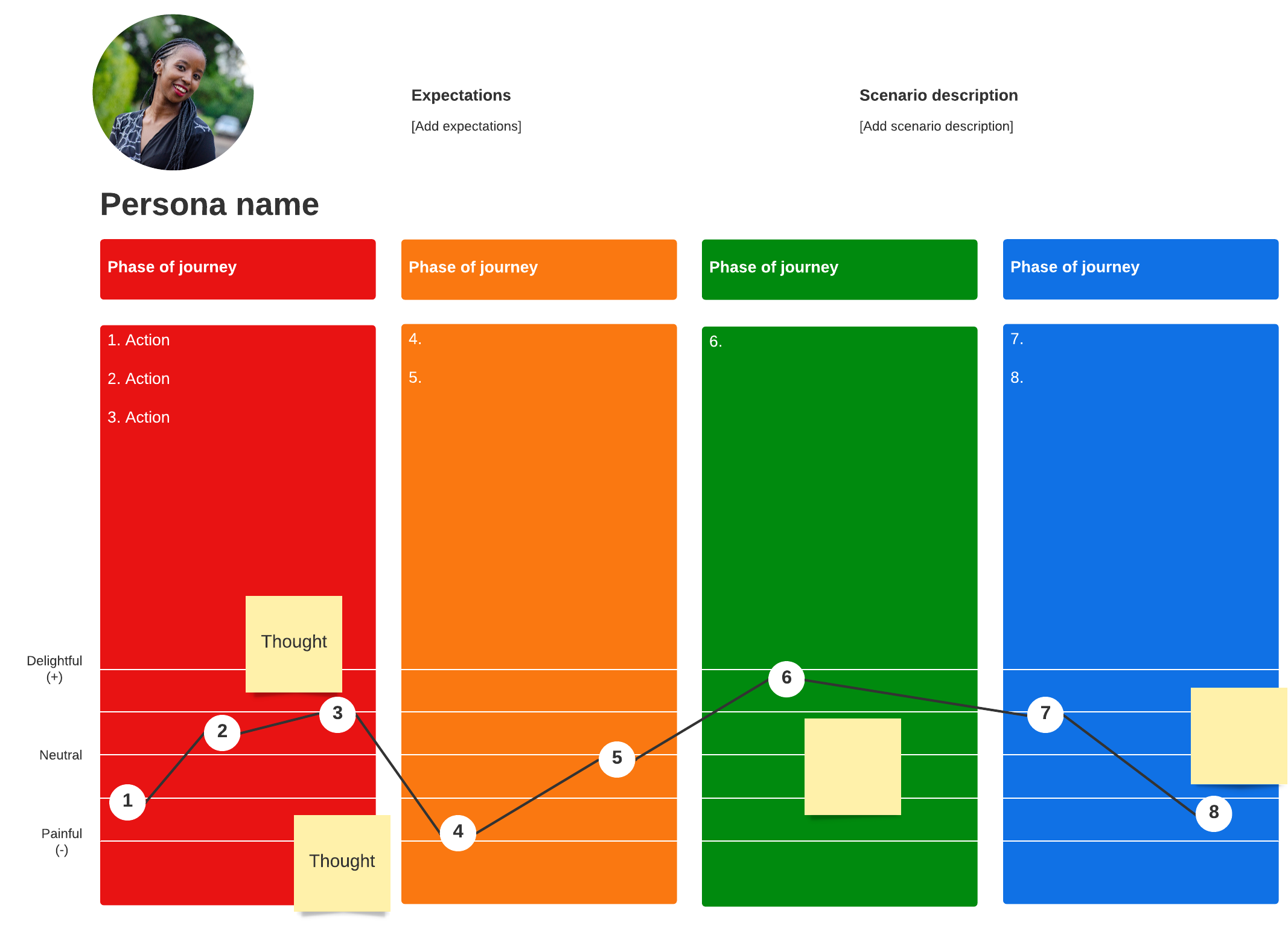How well do you know your users? Chances are, not as well as you think. As professional UX designers, it’s easy to assume you know best how to solve design problems. But that can get you into trouble.
When you make assumptions about your users and what they need, you risk misunderstanding what the real problem is—and end up solving a problem no one needs you to solve.
That’s where Design Thinking comes in. Design Thinking helps you center the user in the design process so that every design choice meets a real human need.
And the first step to Design Thinking is leading with empathy.
Here’s how.
The 5 stages of Design Thinking
Design Thinking is a non-linear, creative, and iterative process for understanding users, challenging assumptions, and developing innovative solutions to prototype and test.
There are 5 stages of the Design Thinking process:
- Empathize—Understand your users and research their needs.
- Define—Identify users’ needs and problems.
- Ideate—Challenge assumptions and start brainstorming and generating solutions.
- Prototype—Build out your best ideas.
- Test—Test your prototypes, identify issues, and refine your solution.
These stages are not necessarily sequential though. Since Design Thinking is non-linear and iterative, teams can be working through multiple stages in parallel (and returning to the “blackboard” often) as they work towards solutions.
The role of empathy in Design Thinking
Design Thinking is about putting people at the center of your design. And to do that, you first need empathy. Empathetic design means getting into your end users’ heads to really understand their experiences and problems so you can design better solutions. (And then continue experimenting, testing, and refining those ideas until you have a solid final product.)
It’s easy to make assumptions from behind a desk about what users want in theory. After all, you’re the expert, right? But if you aren’t taking time to understand the user experience and listen to people, you might miss opportunities to design what people actually need.
And that’s bad for users and bad for design.
That’s why empathy during the design process is critical. Developing an empathetic approach to design allows you to shelve your assumptions and get to the heart of what people want and need. In other words, empathy helps you understand the problem better, which leads to better solutions.
Become an empathetic observer
To understand people and connect with their experiences and problems, you have to be an empathetic observer. How do you do that? Empathy in research isn’t something that necessarily comes naturally, but it’s a skill you can cultivate.
As you approach your research, you’ll need to:
- Let go of your ego. In other words, it’s not about you. To understand and empathize with your users, you have to let go of your assumptions and preconceived notions, and center the thoughts, feelings, and experiences of your users.
- Embrace humility. You may be an expert in your profession, but that doesn’t mean you know everything. Practice humility as you observe your users and learn about their experiences. Be open to the fact that you can learn from them and be humble enough to accept new perspectives and consider solutions you hadn’t thought of.
- Actively listen. Good listeners put aside their assumptions and quiet their inner monologue in order to take in what people are communicating. Don’t interrupt or steamroll your users. Instead, let them finish their thoughts so you can fully understand their perspective and experience.
Empathy requires practice, but as you cultivate empathy in your design thinking, you’ll be a more effective researcher and UX designer.
Best practices for the Empathize stage of Design Thinking
Empathy can be tough to get our heads around because it’s a soft skill (and a feel-good one at that). Use the following practical tips for building and applying empathy in Design Thinking.
Follow the 4 phases of empathetic research
There are four main research stages for empathetic design: discovery, immersion, connection, and detachment. Follow these steps to make sure your research is not only accurate and thorough but also empathetic. The goal is to develop empathy for your users with intention so you can make a meaningful impact on their lives.
Discovery
During the discovery phase, you’re entering the world of the user and making connections. Identify and approach your users to start uncovering their behaviors and the (often unspoken) reasons for their behavior.
Immersion
Immersion is all about putting yourself into your users’ shoes. This involves fieldwork—actually going to your users’ environments to conduct research, perform the same activities, and learn first-hand what problems and needs exist.
Connection
The next step is to connect with your users’ experiences through your observations and research. It’s not enough to just go through the motions recreating your users’ experiences. It’s about getting curious and diving deeper to find what resonates. This is where you can build true empathy for your users’ and their specific needs.
Detachment
Finally, you need to take a step back and look at the problem zoomed out to a designer’s lens. Reflect on your experience and learnings then start to pull out key insights and generate ideas.
Assume a beginner’s mindset
So what does it mean to have a beginner’s mindset? It means starting with fresh eyes and no assumptions when you approach your research.
This is a key part of Design Thinking with empathy because it helps you better understand how your users think about and experience problems (or your products). As you research and observe your users, always question your assumptions (even if you think you know the answer already), and listen openly.
Use an empathy map
An empathy map is a simple visual that outlines knowledge of your users’ behaviors and attitudes. Empathy maps help you build empathy for your users, synthesize your observations, and uncover key insights from your findings.
Pro Tip: Empathy maps are most useful early in the design process (after user research but before requirements and prototyping).
Get started by defining your goal or purpose then gather your user research data around that focus. You can map out your findings on paper or use a digital whiteboard like Lucidspark to keep all your insights organized in one shareable place. The Lucidspark template clearly demarcates the different fields of knowledge into what users say, think, feel, and do (with additional boxes for outlining wants, needs, and pain points).

You can either fill out the empathy map yourself, or have your users fill it in directly. Both exercises are useful ways to collect information and organize user insights. Once your quadrants are filled out, review the answers and reflect with your team. What stands out? What surprised you? What new insights or conclusions can you draw from this data?
Empathy mapping is one tool for building empathy for your users while uncovering key insights about their needs and wants. Use it to create a foundation of empathy for your design process and don’t be afraid to return to it, add to it, and revise as you gather more data and iterate from there.
Ask the 5 Whys
The “5 Whys” is a simple but effective problem solving method that helps you dig deeper to the heart of an issue. The premise is straightforward: when faced with a problem, ask why the problem exists. Then ask why again for the answer you came up with. Keep asking “why” three more times. (You may sound like a curious toddler, but repeatedly asking “why” is a powerful tool for understanding a problem on a deeper level).
Each time you ask why, you force yourself to move past surface-level symptoms to the root cause. When you reach the end, you reveal a single reason for your issue and can then brainstorm a solution (also known as a “countermeasure”) to address the cause of the problem (rather than its symptoms).
Create customer journey maps
Like empathy mapping, customer journey maps help designers get into the heads of their users and focus on their needs.
Both maps are built from the customer point of view, but journey mapping visualizes the entire customer experience with the brand over time whereas empathy maps hone in on a narrow view of a specific persona. In fact, multiple empathy maps can be incorporated into one customer journey map to illustrate user experiences at each unique touchpoint along the way.
Kickstart the process with a ready-made customer journey template from Lucidspark. The collaborative online whiteboard makes it easy to map your customer data, add sticky notes and commentary, and visualize your users’ journeys.

Conduct interviews with empathy
User interviews are a core part of Design Thinking. Meeting with customers face-to-face to ask them about their experiences, feelings, and behaviors is a powerful way to understand your users more intimately (and accurately). This process will both build and require empathy.
To get the best results
- Prepare a list of questions ahead of time.
- Keep asking “Why?” to delve deeper into people’s behaviors.
- Leave your assumptions at the door.
- Listen intently.
By remaining open and humble, you can uncover answers to questions you wouldn’t have otherwise thought to ask.
Pro Tip: Gather and summarize your interview data in Design Thinking empathy maps to better contextualize the information and bring out new insights
Design Thinking with empathy takes practice—but luckily, it’s an iterative process, so you’ll have lots of time to get it right. Use these tips and best practices to keep your users center stage throughout the process and develop solutions that solve real problems for your customers every time.

The first step to better empathizing with your customers is to capture their experience using an empathy map template in Lucidspark.
Get startedAbout Lucidspark
Lucidspark, a cloud-based virtual whiteboard, is a core component of Lucid Software's Visual Collaboration Suite. This cutting-edge digital canvas brings teams together to brainstorm, collaborate, and consolidate collective thinking into actionable next steps—all in real time. Lucid is proud to serve top businesses around the world, including customers such as Google, GE, and NBC Universal, and 99% of the Fortune 500. Lucid partners with industry leaders, including Google, Atlassian, and Microsoft. Since its founding, Lucid has received numerous awards for its products, business, and workplace culture. For more information, visit lucidspark.com.

